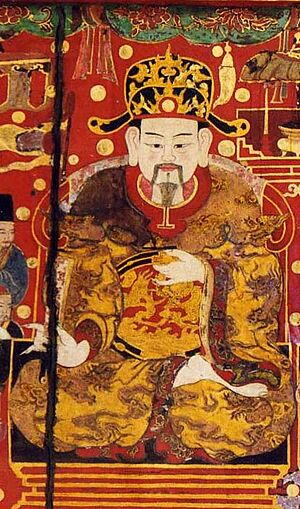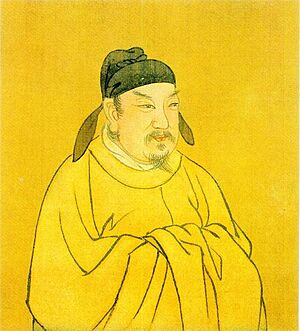Lý Nam Đế facts for kids
Quick facts for kids Lý Nam Đế李南帝 |
|||||||||||||
|---|---|---|---|---|---|---|---|---|---|---|---|---|---|
| Emperor of Vạn Xuân Emperor of Yuè |
|||||||||||||

Lý Nam Đế, Nguyễn dynasty lacquerware painting
|
|||||||||||||
| Emperor of Vạn Xuân | |||||||||||||
| Reign | 544–548 | ||||||||||||
| Successor | Triệu Việt Vương | ||||||||||||
| Born | 17 October 503 Phổ Yên, Thái Nguyên, Liang China |
||||||||||||
| Died | 13 April 548 Tam Nông, Phú Thọ, Vạn Xuân |
||||||||||||
| Consort | Hứa Trinh Hòa | ||||||||||||
|
|||||||||||||
| House | Lý | ||||||||||||
| Dynasty | Early Lý | ||||||||||||
| Father | Lý Cạnh | ||||||||||||
| Mother | Lê Thị Oánh | ||||||||||||
Lý Nam Đế (born around 503, died April 13, 548) was a very important leader in Vietnamese history. His real name was Lý Bí or Lý Bôn. He was the first emperor of the Early Lý dynasty in Vietnam. He ruled from 544 to 548. Before becoming emperor, he worked as a government official for the Chinese Liang dynasty in a region called Jiaozhou, which is now northern Vietnam.
Contents
Lý Nam Đế: A Brave Leader
Lý Bôn came from a family whose ancestors were Chinese. They had moved to the Red River Delta many centuries before. Lý Bôn worked as a local official for the Chinese Liang dynasty. At this time, China was having many civil wars. Lý Bôn became very upset with the government. He saw a lot of corruption and unfair treatment of the local people.
Starting a New Kingdom
Lý Bôn decided to take action. His friend, Phạm Tu, helped him train a small army. In 541, Lý Bôn quit his job and started a rebellion against the Liang dynasty. He brought together local leaders and tribes from the Red River Valley. He built an army and a navy. In the summer of 543, his forces won a big battle in Hepu. This victory pushed the Liang dynasty out of northern Vietnam.
In February 544, the people declared Lý Bôn their emperor. This showed that he was equal in power to the emperors of China. He named his new kingdom "Vạn Xuân", which means "Eternal Spring." His armies also fought off attacks from the Champa kingdom in the south. Champa had teamed up with the Liang dynasty.
Building and Protecting Vạn Xuân
Lý Nam Đế set up his capital city in Long Biên, which is now Hanoi. He chose strong leaders to help him with military and government tasks. Famous military commanders like Phạm Tu, Triệu Túc, Tinh Thiều, and Triệu Quang Phục supported him. Triệu Quang Phục later became a hero and took over as ruler after Lý Nam Đế.
Lý Nam Đế built many forts in important places across Vạn Xuân. These forts helped protect the kingdom from possible attacks from China in the north and Champa in the south. He also started the first national university for scholars. He made changes to how land was owned and encouraged more people to learn to read and write. He set up many new rules for society, similar to how China was organized.
Challenges and Legacy
However, the new kingdom did not stay peaceful for long. In October 544, the Liang dynasty sent a large army to take back Jiaozhou. This army was led by a general named Chen Baxian. By spring 545, Chen's army had caused a lot of damage in Jiaozhou. Lý Nam Đế's forces managed to hold them off for several months.
But in the winter of 545, Chen's army surprised the capital during the rainy season. Lý Nam Đế's army was caught off guard. His court had to leave Long Biên and escape into the western highlands. The Lý army became very tired, and Lý Nam Đế himself became very sick from being in the wilderness for months.
Lý Nam Đế realized his illness meant he could not lead his troops effectively. In February 548, he gave up his power. He transferred control to his older brother, Lý Thiên Bảo, and his best general, Triệu Quang Phục.
In April 548, Lý Nam Đế died in northwest Vietnam. He was killed by local tribesmen who hoped to stop the invading Liang army. His immediate successor was Triệu Quang Phục, who became known as Triệu Việt Vương. Triệu Việt Vương continued the fight and eventually drove the Chinese out of Vạn Xuân in 550.
Even though China would later occupy Vietnam for a long time, Lý Nam Đế successfully created a state that gave northern Vietnam about 60 years of independence. He is remembered as a brave leader who fought for his people's freedom.
Rulers of the Early Lý Dynasty
- Lý Nam Đế I (ruled 542–548)
- Lý Thiên Bảo (ruled 548–555, shared power with Triệu Quang Phục)
- Triệu Việt Vương (ruled 548–571, ruled alone from 555–571)
- Lý Nam Đế II (ruled 571–602)



